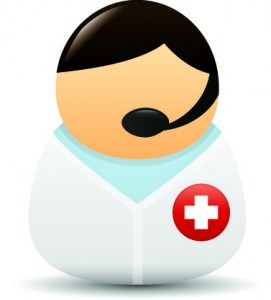Healthcare with Confidence
Infringement of the ulnar nerve (ulnar tunnel syndrome) occurs when the ulnar nerve in the hand is compressed or irritated.
The ulnar nerve is one of the three main arms of nerves. It extends from the neck down to the arm and can be narrowed down in several places, for example, below the clavicle or the wrist. The most common nerve compression point is the rear or inner part of the elbow.
Common symptoms of ulnar tunnel syndrome are numbness and tingling in the hands and fingers. In most cases, symptoms may be controlled by conservative treatments, such as altering activity. If conservative methods do not eliminate the symptoms or nerve compression causes muscle weakness or hand injury, doctor may recommend surgery.
The ulnar nerve passes through a tunnel in the tissue (cubital tunnel), and follows a bump on the inner side of the bone of the elbow. This bony bump called the medial epicondyle. The place where the nerve passes under the medial epicondyle is commonly referred to as the “funny bone.” At this point, the nerve passes very close to the skin, and when touched, there is a very painful sensation, like a shock.
The ulnar nerve provides the sensitivity of the little finger and half of the ring finger. It also controls most of the small muscles in the hand that helps perform small movements.
Leading doctors in hand therapy and surgery in Israel:
Dr. Igo Goldberg – Senior surgeon surgery department of the arm and hand, Rehabilitation Center for hands treatment of, Israel.
Dr. Batya Yafe – specialist in plastic surgery arm and hand. Head of the Department of micro-surgery arm and hand in the Sheba Medical Center, Tel Hashomer.
⇒ Best orthopedists of Israel 2022 – Forbes
In many cases, the exact cause of ulnar tunnel syndrome is not known. The ulnar nerve is particularly vulnerable to compression at the elbow, as he has to go through a narrow space with very little soft tissue that protects it.
The ulnar nerve passes behind the medial epicondyle on the inside of the elbow.
There are several factors that can cause pressure on the nerve in the elbow:
In the elbow flexed position, the ulnar nerve is stretched around the ridge of the medial epicondyle. As this stretching can cause nerve irritation, hold the elbow in a bent position for a long time or repeated flexion of the elbow can cause painful symptoms. For example, many people sleep with flexed elbows. This may aggravate the symptoms of compression of the ulnar nerve and cause the patient to wake up at night.
In some people, the nerve slips out of the medial epicondyle when the elbow is bent. Over time, this sliding back and forth can irritate the nerve.
Bearing on the elbow during a long period of time may exert pressure on the nerve.
Accumulation of fluid in the elbow can cause tumor which can compress the nerve.
Direct strike on the inner side of the elbow can cause pain, electric shock sensation and numbness in the little finger and ring finger.
Sleep with bent elbows may aggravate symptoms.
Several factors put you more at risk for the development of the ulnar tunnel syndrome. These include:
♦ Fracture or dislocation of the elbow
♦ Bone spurs / elbow arthritis
♦ Swelling elbow
♦ Cysts near the elbow
♦ Repeated or prolonged actions that require the elbow flexed position.
Symptoms
Ulnar tunnel syndrome can cause aching pain in the inner side of the elbow. Most of the symptoms, however, occur in the hand.
Numbness and tingling in the ring finger and little finger are common symptoms of infringement of the ulnar nerve. Often, these symptoms come and go. They occur most often when the elbow is bent, for example, while driving or when holding the phone in hand. Some people wake up at night from the numbness of the fingers.
The feeling of “falling asleep” in the ring finger and little finger, especially when the elbow is bent. In some cases it may be more difficult to move the fingers and manipulate objects.
The weakening of the grip and finger coordination difficulties (such as play a musical instrument). These symptoms usually occur in more severe cases of nerve compression.
If very nerve compressed or is compressed for a long time in the hand thinning can occur muscle, which leads to loss of muscle mass. For this reason it is very important to consult a doctor if symptoms are severe or if they are less severe, but were present for more than 6 weeks.
Diagnosis
First, doctor discusses with the patient the story of his illness, as well as overall health. It may ask the patient about his work, activity, and medications the patient is taking is possible.
After a discussion of symptoms and medical history, the doctor will examine the hand to determine which nerve is pinched and where. Some of the physical examination tests doctor can recommend include:
Tests
♦ X-rays. This test provides detailed images of dense bone structures. Most causes compression of the ulnar nerve can not be seen on X-rays. However, doctor may take X-rays of the elbow or wrist to detect bone spurs, arthritis, or evidence that the bone can compress the nerve.
♦ Nerve conduction studies. These tests can determine how well the nerve function and help determine where it is compressed. Nerve conduction studies measure the signals traveling along the nerves of arm and hand. Nerves as “electric cables” which pass through the body, carry messages between the brain and muscles. When the nerve is not fulfilling its function properly, the conductivity takes a long time.
During testing of nerve conduction, the nerve is stimulated in one place, and thus its response is measured. Where readings suggest slow reaction, perhaps, there is a place where nerve is compressed. Nerve conduction studies can also determine whether compression also causes muscle damage. During the test in some of the muscles of small needles are placed. Damage to the muscles is a sign of a more serious nerve compression.
Treatment
If the compression of the nerve causes atrophy of the muscle, doctor likely primarily recommend non-surgical treatment.
♦ Nonsteroidal anti-inflammatory drugs. If the symptoms have just started, doctor may recommend anti-inflammatory drugs to help reduce swelling around the nerve. Although steroids such as cortisone, are very effective anti-inflammatory drugs, steroid injections usually not used because of the risk of nerve damage.
♦ Doctor may prescribe an elbow fixation in the erect position during sleep.
♦ Exercises. Some doctors believe that the exercises that help the ulnar nerve to slip through the cubital tunnel and Guyon’s canal in the wrist can eliminate the symptoms. These exercises can also help prevent stiffness in the hand and wrist.
♦ Surgical intervention. Doctor may recommend surgery to relieve nerve pressure if:
1. Non-surgical methods have not led to an improvement.
2. The ulnar nerve is compressed to a significant degree.
3. Nerve compression caused muscle weakness or damage.
There are several surgical procedures that reduce the pressure on the ulnar nerve. Orthopedic surgeon discusses with the patient the most suitable option for him.
These procedures are often performed on an outpatient basis, but some patients may be better to stay on one night of hospitalization.
The release of the ulnar nerve. When this operation is separated from the cubital tunnel ligament. This increases the size of the tunnel and reduce pressure on the nerve. After the procedure, a bunch begins to heal, and throughout the site starts to grow new tissue. The new growth of tissue ligaments and heals creates more space for the passage of the ulnar nerve.
Anterior transposition of the ulnar nerve. In this procedure, the nerve moves from his seat behind the medial epicondyle to a new location in front of it.
The nerve can be moved under the skin and fatty tissue, the upper portion of the muscle (subcutaneous transposition) or muscle (intermuscular transposition), muscle or under the (axillary transposition).
Medial epicondylectomy. Another option is to release the nerve is to remove part of the medial epicondyle. As in the transposition of the ulnar nerve, this method also prevents the nerve from pressure and stretch, when the elbow is bent.
Depending on the type of surgery, the patient has to wear a retainer sometimes within a few weeks after surgery. Normally, under the axillary muscle transposition requires a longer fixation time (3 to 6 weeks).
Surgeon may recommend physical exercise to help regain strength and movement in his hand. Doctor also tells the patient about when it is safe to return to their normal activities.
The results of operations are usually good. Each method of surgery has a similar success rate for conventional cases of nerve compression. If strongly pinched nerve, or if there is muscle atrophy, it is possible that the nerve can be impeccably and some symptoms may persist even after the operation. The nerves recover slowly, and it may take a long time to determine how well the nerve will function after surgery.



